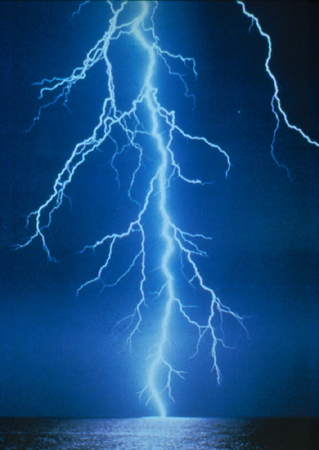Here at Earthtechling, we cover all kinds of technologies that harvest power from the sun, the wind, the waves, human activity, and even minute vibrations. But this is the first technology we’ve seen that claims to harvest electricity directly from the air.
Scientists, like the rest of us, are no strangers to the concept of static electricity. But a reliable way to harness the electricity that exists naturally in the atmosphere has haunted them for decades–including no less of a pioneer in the world of electricity than Nikola Tesla, the inventor of today’s alternating current (AC). In Tesla’s day, it was a well-known fact that sparks of static electricity formed as steam escaped from boilers in factories. That’s because static electricity is formed when water vapor collects on microscopic particles of dust and other material in the air. But until now, scientists lacked adequate knowledge about the processes involved in the formation and release of electricity from water in the atmosphere to be able to harvest it.

Although the research is still in its earliest stages, Fernando Galembeck, Ph.D., of the University of Campinas in Campinas, SP, Brazil, recently presented findings at the 240th National Meeting of the American Chemical Society in Boston that could make harvesting atmospheric electricity a reality. His study found that while scientists once believed that water droplets in the atmosphere were electrically neutral–and remained so even after coming into contact with the electrical charges on dust particles and droplets of other liquids–there is evidence suggesting that water in the atmosphere actually does pick up an electrical charge. Galembeck and colleagues confirmed that idea, using laboratory experiments that simulated water’s contact with dust particles in the air, working with tiny particles of silica and aluminum phosphate, both common airborne substances. Their results show that silica became more negatively charged in the presence of high humidity, while aluminum phosphate became more positively charged.
“Our research could pave the way for turning electricity from the atmosphere into an alternative energy source for the future,” said Galembeck, in a statement. “This was clear evidence that water in the atmosphere can accumulate electrical charges and transfer them to other materials it comes into contact with. We are calling this ‘hygroelectricity,’ meaning ‘humidity electricity’.” In the future, he added, it may be possible to develop collectors, similar to the solar cells that collect sunlight to produce electricity, to capture hygroelectricity and route it to homes and businesses. (Just as solar cells work best in sunny areas of the world, hygroelectrical panels would work best in areas with high humidity.)
Like what you are reading? Follow us on RSS, Twitter and Facebook to get green technology news updates throughout the day and chat with other green tech lovers.